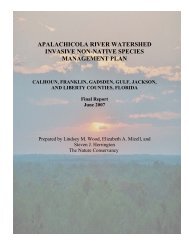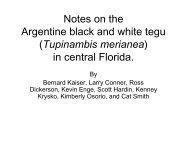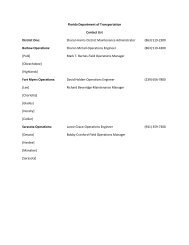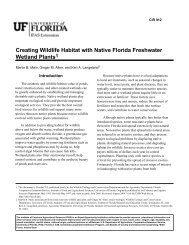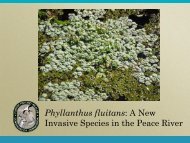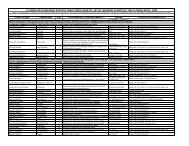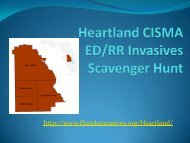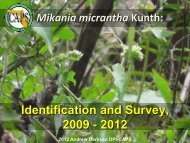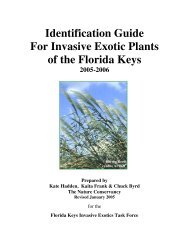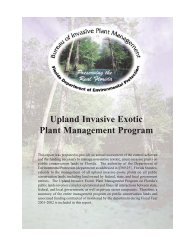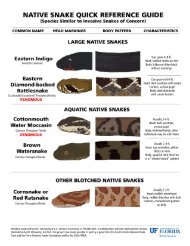FWC BIOPROFILE FOR THE ARGENTINE BLACK AND WHITE TEGU
FWC BIOPROFILE FOR THE ARGENTINE BLACK AND WHITE TEGU
FWC BIOPROFILE FOR THE ARGENTINE BLACK AND WHITE TEGU
- No tags were found...
You also want an ePaper? Increase the reach of your titles
YUMPU automatically turns print PDFs into web optimized ePapers that Google loves.
2often browner than adults, which are typically black and white. Tupinambis merianaediffers from its congeners, T. rufescens and T. duseni, in having a high number of femoralplus precloacal pores (20–25) (Fitzgerald et al. 1999). Tegus are the largest terrestriallizards in the New World, and T. merianae and T. rufescens are the largest tegu species,reaching up to 145 cm (57 in) total length (TL). Male T. merianae may attain 50 cmsnout-vent length (SVL) (Duarte Varela and Cabrera 2000) and weigh 8 kg (17.6 lb)(Lopes and Abe 1999). Males get larger than females, and large adult males havemassive heads and jowls.Fig. 1. Hatchling Tupinambis merianae showing green coloration that later fades (K. Enge).c. GeneticsMitochondrial DNA analysis indicates a deep divergence between the northern andsouthern clades (Fitzgerald et al. 1999). In the southern clade, T. merianae is the sistergroup to T. rufescens and T. duseni. Tupinambis rufescens derived from a T. merianaelikeancestor and is restricted to the dry chaco of Bolivia, Paraguay, and Argentina(Fitzgerald et al. 1999). Tupinambis duseni is genetically similar to T. rufescens; it mayhave split recently from a T. rufescens ancestor and may be experiencing rapiddivergence in squamation, coloration, and morphometrics in the isolated cerrado habitats(Fitzgerald et al. 1999).
32. DISTRIBUTIONa. Native rangeTupinambis merianae occurs in southeastern Brazil, Uruguay, eastern Paraguay andnorthern Argentina (Luxmoore et al. 1988). In Brazil, it occurs south of the AmazonasRiver in southern Amazonia (Vanzolini et al. 1980), extending at least as far north as thestate of Rondônia at 11 o S latitude (Gainsbury and Colli 2003). In Argentina, it extends asfar south as Rosario at 33 o S latitude (Presch 1973) and possibly to 41 o S (Langerwerf2006).i. Expansion/contractionTupinambis merianae is heavily harvested in Paraguay and Argentina for meat andskins, but this has apparently not affected their native range (Norman 1987,Luxmoore et al. 1988, Fitzgerald 1994). In the state of São Paulo in southeasternBrazil, there has been a dramatic reduction in natural habitat for the tegu because ofincreasing growth of agricultural (e.g., sugarcane fields and citrus plantations) andpasture areas, and tegu populations in the few remaining forests are vulnerable tohunting (Abe 1999).ii. Relative abundanceThere are no density estimates, but tegus are common. Tegus are one of the mostabundant lizards in southern Brazil (Milstead 1961). In eastern Paraguay, tegupopulations initially increase when forested areas are opened up for agriculture, buthuman harvest usually reduces these populations (Norman 1987). Active teguhunters in eastern Paraguay each killed an average of 15.8 T. merianae/rufescens in 1year (Norman 1987).b. Habitati. Physical (substrate, temperature, flow, depth)Tupinambis merianae is typically observed in primary forest clearings, secondaryforest, and other disturbed habitats such as roadsides and fence rows (Fitzgerald1994). It occurs from sea level to an altitude of 1250 m (4100 ft) in northwesternArgentina (Presch 1973).ii. General: terrestrial, freshwater, estuarine, marineTegus are terrestrial, although they may live along freshwater streams, swamps, lakes,and oceans (Martuscelli and Olmos 1996). Tegus have been caught in gill nets set atsea off the rocky shores of São Sebastião Island, Brazil, and will completelysubmerge for extended periods of time in fresh water (Olmos 1995).iii. Chemical (pH, dissolved oxygen, salinity)Tegus are apparently tolerant of at least short-term submersion in salt water (Olmos1995).
iv. Biological (plant cover species associations)In forested habitats, tegus often use clearings or edges. Tupinambis merianae is acharacteristic inhabitant of much of the diagonal corridor of open habitats (Vanzolini1963) or xeric vegetation (Bucher 1982) extending from northwestern Argentina tonortheastern Brazil, which includes the Caatinga, Cerrado, and Chaco biomes (Colliet al. 2002, Oliveira-Filho and Ratter 2002). The Caatinga biome of northeasternBrazil might be beyond the range of T. merianae, although some accounts refer to thisspecies from there (e.g., Homewood 1995). The Cerrado receives 900–1800 mm(35–70 in) of rainfall annually and has a 3–4 month dry season, whereas the Caatingaand Chaco biomes typically receive
5Colli 2003). In eastern Paraguay, T. merianae inhabits relatively moist vegetationalassociations, especially gallery forests of river drainages, whereas T. rufescensinhabits drier to semi-arid vegetational associations (i.e., the Chaco) (Norman 1987).In Uruguay, T. merianae inhabits stony meadows, river valleys and mountains(Gudynas 1981).c. Introduced rangei. References, studiesThere may be an established population southeast of Tampa in eastern Hillsboroughand western Polk counties, Florida. Specimens and credible observations exist in thearea of Balm north of County Road (CR) 672 and bounded by Balm-Riverview andBalm-Boyette roads. These observations stretch for ca. 3.2 km (2.0 mi) north-south(N-S) and 4.5 km (2.8 mi) east-west (E-W) (Fig. 2). The Balm-Boyette Scrub NaturePreserve, which is managed by the Hillsborough County Parks, Recreation andConservation Department, is located in this area. The preserve encompasses 1990 ha(4916 ac) and contains the following natural habitats: sand pine scrub, xeric oakscrub, scrubby and mesic flatwoods, hardwood hammock, freshwater marsh, cypressswamp, and hardwood swamp (Resource Management Office 2006). The east end ofthe preserve contains 486 ha (1200 ac) of restored phosphate-mined land that consistsof improved pasture and numerous lakes (Resource Management Office 2006). Anadult tegu was first collected in the preserve in June 2006 (Fig. 3), and tegus havebeen subsequently observed here. For example, 2 juvenile tegus were observedescaping into gopher tortoise (Gopherus polyphemus) burrows during a 20-min visiton 18 August 2006 (Kaiser, pers. comm.). Three juvenile tegus have beensubsequently trapped from 10 tortoise burrows, although 1 escaped while beingremoved from the trap. Tegus, including hatchlings, have also been observed onprivate property in the area in 2006. The next road east of this area is CR 39, andthere have been 3 credible tegu observations along this road. There have also been 2credible tegu observations and a photo (Fig. 4) from farther east on MosaicPhosphates land in western Polk Co. The total area encompassed by theseobservations stretches ca. 22.5 km (14 mi) E-W and 3.2 km (2 mi) N-S.Tupinambis merianae was introduced in the 1970s to the national park Fernando deNoronha, an island 500 km off the northeastern coast of Brazil, to control rats(Homewood 1995). After increasing for a few years, the tegu population stabilized,but it still threatens nesting shorebirds and sea turtles (Homewood 1995, Ziller 2006).A population of T. teguixin has become established on the island of San Andrés,Columbia, as a result of the release of juveniles from a pet trade shipment in 1984(Fitzgerald et al. 2005). A reptile dealer released 200 golden tegus (T. teguixin) in the1980s in northwestern Miami (Powell, pers. comm.), but there is no evidence of anestablished population there (Enge, pers. obs.). In 1994, a T. teguixin was observed inRoyal Palm Hammock, Everglades National Park (Butterfield et al. 1997), andMeshaka et al. (2004) reported sightings of this species at a park in North Miami andon Key Biscayne in Miami-Dade County. A former keeper at the Crandon Park
6Fig. 2. Map of Tupinambis merianae sightings southeast of Tampa in eastern Hillsborough andwestern Polk counties, Florida, as of 1 September 2006 (L. Connor).Fig. 3. Tupinambis merianae collected in Balm-Boyette Scrub Nature Preserve, HillsboroughCo., Florida, in 2006 (B. Chamberlin).Zoo on Key Biscayne claims tegus (Tupinambis sp.) were sometimes observed eatingturtle eggs on the grounds, but these were probably misidentified giant ameivas(Ameiva ameiva); no tegus have been observed since the zoo closed in 1979 (Kryskoet al., unpubl. ms.). However, V. Cassidy photographed a T. teguixin (UF #149983),which was probably a recently released individual, at Crandon Park on 21 July 2006.Also in Miami-Dade County, a resident of Tropical Park sent a photograph to the
7Fig. 4. Adult male Tupinambis merianae observed at “Bald Mountain” on Mosaic Phosphatesland, Polk Co., Florida, in 2004 (J. Guzy, Biological Research Associates).Florida Museum of Natural History of a Tupinambis sp. living in a burrow in hisbackyard (Krysko, pers. comm.). A road-killed adult T. merianae (UF #135044)found in the town of Okeechobee, Okeechobee Co., in 2002 probably represents asingle escapee.ii. Pathway(s)The most likely source of the Florida population is the release by a dealer ofspecimens imported from Paraguay in 2000–2002 that had broken tails or otherdefects that affected their salability. The purpose of this illegal release might havebeen to establish a population for future exploitation (e.g., Krysko et al. 2003) or toavoid killing unwanted animals. The dorsal banding pattern of the 2 adult voucherswe have from this wild population indicates that they are of Paraguayan origin (St.Pierre, pers. comm.). This tegu species is still not very common in the pet trade, sothe likely source of the Tampa population is not from single releases/escapes fromseveral pet owners but instead to releases/escapes of multiple animals by a breeder ordealer. However, tegus sometimes escape from outdoor enclosures because of theirpropensity for burrowing, and their speed makes recapturing non-tame individualsunlikely. It is possible that the facility of a tegu breeder or reptile dealer could havebeen damaged by hurricanes, resulting in the release of several animals. However,the extensive E-W distribution of sightings possibly indicates releases at multiplesites in suitable-looking habitat. Prior to importation of cheap T. merianae fromParaguay, almost all specimens available in the pet trade were captive bred and worthtoo much money ($250 for hatchlings) to consider releasing, but afterwards,wholesale prices for hatchlings dropped to $35 each (Pierre, pers. comm.).
83. BIOLOGYa. Reproductioni. Time of yearIn eastern Paraguay, T. merianae mates from late September through earlyNovember, and eggs laid around mid-November hatch from late December throughearly January (Norman 1987). In subtropical Argentina, captive females laid eggs inlate October and November, the beginning of the wet spring (Yanosky and Mercolli1995). In temperate seasonal conditions in Córdoba province, Argentina, eggs hatchfrom mid-January to late March (Duarte Varela and Cabrera 2000). In outdoor cagesin Loxahatchee, Palm Beach Co., Florida, tegus typically bred in March, althoughcold fronts in March sometimes delayed breeding for up to 1 month (St. Pierre, pers.comm.). Males were apparently prone to sterility at high temperatures, and gravidfemales exposed to cold temperatures laid eggs with dead embryos (St. Pierre, pers.comm.). In northern Alabama, T. merianae started breeding in mid-April(Langerwerf and Paris 1998). Tegu eggs in Palm Beach County started hatching inJune (St. Pierre, pers. comm.), so in Hillsborough County, eggs probably hatch inJuly–August because of the more northerly location and natural incubationtemperatures.ii. Minimum ageIn the wild in Paraguay, female T. merianae do not breed until their third or fourthyear (Fitzgerald 1994). Female T. merianae measuring 30 cm (11.8 in) SVL areready to mate (Yanosky and Mercolli 1992b). Tegus could possibly be reared toadult size in 1 year if the normal winter dormancy period were suppressed byincreasing the temperature and light (Yanosky and Mercolli 1993). In captivity innorthern Alabama, the earliest reproduction was observed at 3 yr of age (Langerwerf2006). However, well-fed captive females in southern Florida have reproduced at 10months old and ca. 61 cm (24 in) TL (St. Pierre, pers. comm.).iii. FrequencyTegus lay only 1 clutch of eggs annually. Eggs are white and porous-shelled butbecome stained from the nesting material during incubation (Yanosky and Mercolli1992b).iv. FecunditySeven captive specimens in Argentina laid 24–49 (mean = 30) eggs (Yanosky andMercolli 1991). The average clutch size has been reported as 36 eggs, ranging from20 to 54 eggs (Donadío and Gallardo 1984). Captive specimens in southern Floridatypically laid ca. 20 eggs during their first year of reproduction and 30–35 eggsduring their second year of reproduction, with older laying 40–54 eggs (St. Pierre,pers. comm.). Small females in northern Alabama laid ca. 12 eggs, and large femaleslaid 30 or more eggs (Langerwerf 2006). The largest clutches reported from the wildin Argentina contained 54 eggs (Serié 1932, Yanosky and Mercolli 1992b).
9b. Early life historyEggs average 42 mm long and weigh 18.7 g when laid, increasing to 25.6 g after 7 weeks(Yanosky and Mercolli 1995). Eggs incubated at temperatures that varied from anaverage of 26.4 + 2.2 o C (79.5 + 4.0 o F) in the morning to 30.5 + 3.8 o C (86.9 + 6.8 o F) inthe evening hatched in 61–64 days, and hatching was asynchronous (Yanosky andMercolli 1992b). Eggs incubated at a constant temperature of 30 o C (86 o F) hatch in ca. 60days, and eggs exposed to fluctuating incubation temperatures suffer high mortality rates(St. Pierre, pers. comm.). Eggs exposed to moisture tend to get moldy and die (St. Pierre,pers. comm.). Eggs laid in soil outside in Alabama hatched in ca. 3 months at anestimated mean incubation temperature of 27.8 o C (82 o F) (Langerwerf 2006). HatchlingT. merianae almost “explode” from their eggs (accompanied by squirting fluids),completely hatching in 13months), 33.9–36.0 cm SVL at 3 yr old, 33.0–47.5 cm SVL at 4 yr old, 35.2–49.2 cmSVL at 5 yr old, and 38.4–47.7 cm SVL at 6 yr old (Duarte Varela and Cabrera 2000).The largest male was 11 yr old and measured 50.1 cm (19.7 in) SVL, and the largestfemale was 8 yr old and measured 43.7 cm (17.2 in) SVL (Duarte Varela and Cabrera2000). The oldest male was 12 yr old (43.6 cm SVL) and the oldest female was 10 yr old(36.1 cm SVL) (Duarte Varela and Cabrera 2000). An adult male (ca. 33 cm SVL)caught in southeastern Brazil lived for 17 yr in captivity, making its lifespan possibly 20yr (Brito et al. 2001). For a given length, males are heavier than females until they reacha SVL of 34 cm (13.4 in), when both sexes weigh the same (1.53 kg; 3.36 lb) (Yanoskyand Mercolli 1992b). Females longer than 34 cm SVL weigh more than comparablysized males, but males get larger (Yanosky and Mercolli 1992b).
d. Diet informationTegus have heterodont dentition as adults, with pointed teeth in the front for seizing preyand molariform teeth in the back of their jaws (Dessem 1985). It has been suggested thatthese blunt posterior teeth are used for crushing hard prey items (Presch 1974, Rieppel1980), but development of these teeth when tegus weigh 600–750 g (1.32–1.65 lb) doesnot seem to be correlated with a change in diet to eating hard food items such as mollusks(Dessem 1985). The posterior teeth of the mostly insectivorous juveniles are tricuspidand pointed (Dessem 1985, Norman 1987). Tegus flick their forked tongues to detect anddiscriminate between food and nonfood odors (Yanosky et al. 1993). The species isomnivorous, feeding on vertebrates, invertebrates, and plant matter, including fruit, seeds,leaves, stems, flowers, and honey. According to Cei (1986), it eats birds, smallmammals, insects, mollusks, fishes, amphibians, and fruit. Achaval (1977) claims itsfood consists mainly of insects, snails, bird eggs, fruits, and vegetables. The stomachcontents of adult T. merianae in Argentina contained, by volume, 66.8 % plant material(primarily fruits), 13.4 % invertebrates, and 20.0 % vertebrates (Mercolli and Yanosky1994; Table 1). In Brazil, stomach contents, by volume, consisted of 29.0% plantmaterial, 27.8% ants, 27.5% vertebrates, 13.1% mollusks, and minor amounts oforthopterans, coleopterans, phasmids, and millipedes (Colli et al. 1998). Another studyin Brazil found plant material (Vitis and Philodendron fruits), arachnids, coleopterans,large land snail fragments, orthopterans, caterpillars, and rodents (Milstead 1961).Stomach contents, by volume, of juvenile (8.7–29.9 cm SVL) T. merianae in Brazilconsisted of 47.7% invertebrates (mostly spiders, othopterans, cockroaches, andcoleopterans), 31.9% plant material (mostly 1 banana), and 15.5% vertebrates (mostly 1rodent; Table 1); juveniles were also observed feeding on a nine-banded armadillo(Dasypus novemcinctus) and house sparrow (Passer domesticus) carcass (Kiefer andSazima 2002). Fruits or seeds were found in only 2 of 30 juvenile stomachs containingfood (Kiefer and Sazima 2002), whereas fruits or seeds were found in 62 of 70 adultstomachs (Mercolli and Yanosky 1994). Tegus are predominantly terrestrial; all fruitseaten belonged to trees with fruits that fall to the ground when ripe, and the birds eatenwere chicks of the ground-nesting tinamou (Mercolli and Yanosky 1994). Teguconcentrations are found where ripe Philodendron fruit or fish discarded by fishermen arepresent (Milstead 1961). Based on food items, tegus apparently enter shallow water toprey upon fish, crabs, and snails (Mercolli and Yanosky 1994). Other items eaten byTupinambis spp. include mushrooms, frogs, turtle eggs, reptiles, and carrion (Donadíoand Gallardo 1984, Dessem 1985, Escalona and Fa 1998, Kiefer and Sazima 2002, Silvaand Hillesheim 2004, Toledo et al. 2004). In captivity, tegus fed on 30 species of fruitsfrom southeastern Brazil ranging in diameter from 0.81 to 10.0 cm, including large fruitadapted for dispersal by large mammals (Castro and Galetti 2004). Seed retention in thegut ranged from 22–24 hr to 43–44 hr, and tegus may be important seed dispersers in theNeotropics (Castro and Galetti 2004). Hungry hatchlings will sometimes cannibalizesmaller, weaker siblings, and adults will eat their own eggs and young (St. Pierre, pers.comm.). If given a choice, adults are more prone to feed on small prey items like insectsthan large items like dead adult rats (St. Pierre, pers. comm.). A tegu breeder fed his T.merianae rats, turkey meat, eggs, bread, cat food, dog food, pies, tomatoes, cantaloupes,fish, grapes, pears and pitless cherries (Langerwerf and Paris 1998).10
11Table 1. Most common (by number or percent volume) food items for 70 adult T. merianaefrom northeastern Argentina (Mercolli and Yanosky 1994) and 30 juveniles from southeasternBrazil (Kiefer and Sazima 2002).AdultsJuvenilesFood Taxa N % Volume N % VolumePlantsQueen palm (Syagrus) fruit 244 25.4 1 1.1Caranday wax palm (Copernicia) fruit 222 11.4 0 0Fustic tree (Chlorophora) fruit 1263 7.8 0 0Caranday palm (Trithrinax) fruit 84 7.1 0 0Figs (Ficus monckii) 359 1.9 2 0.9Congorosa (Maytenus) fruit 151 1.8 0 0Myrtle tree (Eugenia) fruit 106 0.9 0 0Spiny hackberry (Celtis) fruit 140 0.6 0 0Soda apple (Solanum) fruit 47 0.6 0 0Surinam cherry (Eugenia) fruit 28 0.2 0 0Longleaf peppertree (Schinus) fruit 27 0.2 0 0Banana (Musa) 0 0 1 25.8Unidentified fruits 116 1.3 4 1.9Gourd (Cucurbitaceae) seeds 0 0 38 0.9Myrtle (Myrtaceae) seeds 0 0 123 0.4Unidentified seeds 75 0.2 45 0.7Vegetable matter – 6.9 7 0.2Total 2870 66.6 221 31.9InvertebratesGastropods 379 6.9 21 3.5Lepidopteran larvae/pupae 56 1.9 15 2.3Coleopteran adults/pupae 69 1.0 54 6.7Crustaceans 21 1.0 3 0.8Spider adults and egg sacs 39 0.9 35 10.3Hymenopteran adults/pupae (mostly ants) 0 0 47 2.4Orthopterans 29 0.9 35 10.2Cockroaches 0 0 21 7.0Millipedes 0 0 13 3.9Insect eggs 0 0 19 0.2Total 793 13.4 385 47.7VertebratesAnurans 49 10.4 2 1.6Rodents 4 3.2 1 13.7Fishes 10 1.9 0 0Snakes 4 1.4 0 0Bird eggs 1 1.4 0 0Birds 5 1.2 2 0.2Total 75 20.0 5 15.5Unidentified 0 0 8 4.9
12e. Parasites and diseaseWild-caught T. teguixin seem prone to high nematode infestations (Sprent 1983, Balsai1998). Tupinambis teguixin is the host of a cestode parasite, Tejidotaenia appendiculata(Baylis 1947, Rego and Chambrier 2000). At least 5 species of haemogregarine bloodparasites have been found in Tupinambis spp. (Osimani 1942). Tegus sometimes developfungal skin problems (Jacobson et al. 2000), which can occur in cold, damp conditions orwhen not fed fruit (St. Pierre, pers. comm.). In Argentina, 10 juvenile T. merianaerefused to feed and lost weight after emerging from their first dormancy period; theydeveloped thin and shrunken tails, but 9 recovered in a month after being force fed andlosing their tails (Yanosky and Mercolli 1992a). Tupinambis merianae raisedcommunally were apparently healthy and did not develop bacterial or viral infections(Yanosky and Mercolli 1993).4. BEHAVIOR <strong>AND</strong> HABITSa. Daily activity patternThis diurnal lizard exhibits marked circadian variation in metabolism, experiencing asignificant increase in metabolism during part of the day (Klein et al. 2006). However,the daily increase in metabolic rate does not occur during the first 2 days after feeding,when animals are less active (Klein et al. 2006). In Atlantic Forest in southeastern Brazil,T. merianae were observed mostly in sunny patches from 0700 to 1600 hr, with highestactivity recorded during the hottest period of the day (1100–1300 hr) and most activityoccurring between 1000 and 1500 hr (van Sluys and Duarte Rocha 1999). Tegus in a zooin Brazil emerged from their burrows in the morning when ambient temperature was ca.23 o C (73 o F), and became active about 2 hr later (ca. 1030 hr) when ambient temperaturewas 27–30 o C (81–86 o C). The first 2 hr of foraging was accompanied by basking, andactivity ceased at 1500–1600 hr when the cage became shaded, but tegus sometimesremain active until sunset in the wild (Milstead 1961). In Venezuela, free-ranging T.teguixin emerged from their burrows in the morning between 0700 and 0920 hr with abody temperature of 19.0–32.0 o C (66.2–89.6 o F) and basked for an average of 110 min(range 60–245 min) during which time body temperatures increased 4.0–14.0 o C (7.2–25.2 o F) to an average of 34.9 o C (94.8 o F), ranging from 30.0 to 39.0 o C (86.0 to 102.2 o F)(King et al. 1994). Tegus were active over a range of body temperatures from 25.7 to40.5 o C (78.3 to 104.9 o F) (mean daily activity temperature for 13 tegus was 33.2 + 1.5 o C[91.8 + 2.7 o F]) for 285–560 min, and retreated to their burrows before sunset at 1630–1820 when body temperatures were 32.0–36.1 o C (89.6–97.0 o F) (King et al. 1994). Thepreferred body temperature of T. teguixin in temperature gradients is 35.2 + 0.6 o C (95.4 +1.1 o F) (Bennett and John-Alder 1984). Juvenile T. teguixin in a terrarium maintainedtemperatures of 34–38 o C (93.2–110.4 o F) when fully fed but allowed them to drop to ca.32 o C (90 o F) when feeding in a cool environment (Cabanac 1985).b. Seasonal activity patternIn Atlantic Forest in southeastern Brazil, Tupinambis sp. were not observed from Marchthrough July (winter), and twice as many were observed in November (spring breedingseason) as in any other month (van Sluys and Duarte Rocha 1999). During the dry andcold winter in southeastern Brazil, T. merianae hibernates for 4–5 months in underground
13burrows at temperatures around 17 o C (62.6 o F) (Abe 1995, Andrade and Abe 1999). InArgentina, tegus hibernate from April to mid-September (Duarte Varela and Cabrera2000), and in Paraguay, tegus are active roughly from October through April (Fitzgerald1994). Tupinambis merianae can survive temperatures as low as 1.7 o C (35 o F)(Langerwerf and Paris 1998). During 6 months of dormancy, tegus typically loose 8–9%of their total body mass (Yanosky and Mercolli 1993). Captive animals in outdoorenclosures in northern Alabama hibernated for ca. 6 months from mid-September (even ifdaytime temperatures were 27–32 o C [80–90 o F]) through mid-March (Langerwerf 2006).Tegus started refusing food in mid-August and began preparing their burrows forhibernation, digging one large communal sleeping chamber that was closed with dirtduring hibernation (Langerwerf 2006). They did not resume feeding until April and hadan activity burst through July (Langerwerf 2006). Captive animals in outdoor enclosuresin Palm Beach Co., Florida, started feeding less in late August and early September,despite warm temperatures, and spent more and more time in their hide boxes (they couldnot burrow), typically emerging in early morning to bask (St. Pierre, pers. comm.). Bylate September or early October tegus stayed in their hide boxes and did not emerge againabout the second week in February; emergence occurred even if temperatures were cool(St. Pierre, pers. comm.). After emergence from hibernation, tegus lie around basking alot before beginning a period of intense feeding prior to breeding (St. Pierre, perscomm.). In captive breeding groups, dominant males mate with the largest females andsuppress breeding by subordinate males (Fitzgerald et al. 1991).While hibernating, oxygen consumption is reduced to ca. 32% of the value reported forresting lizards during the active season at the same temperature (Abe 1995). Hibernatinglizards do not become active during occasional rises in environmental temperature,indicating the occurrence of true metabolic depression (Andrade and Abe 1999).Dormant lizards at 17 o C (62.6 o F) exhibit an episodic ventilatory pattern consisting of 1–22 breaths followed by non-ventilatory periods lasting 1.8–26 min (Andrade and Abe1999). Dormant lizards at 25 o C (77 o F) exhibit a uniform ventilatory pattern and higherrates of oxygen consumption and ventilation. Breathing during dormancy at 17 o C(62.6 o F) is the most costly activity, consuming 52.3% of the total metabolic rate(Andrade and Abe 1999). For first-year tegus, rates of oxygen consumption duringwinter dormancy are only 20% of the values in the active season and are nearlytemperature insensitive over the range of 17–25 o C (62.6–77 o F) (Souza et al. 2004).Young tegus will decrease their metabolism to the low rates seen during winter dormancyat any time of the year, if exposed to cold (17 o C; 62.6 o F) and dark conditions sufficientlylong (Milsom et al. n.d.). During winter dormancy, larger tegus (3.0–3.75 kg; 6.6–8.3 lb)are more responsive than smaller tegus to changes in the high temperature range (25 o and30 o C; 77 o and 86 o F), indicating that reproductively active adults are more prone toprompt arousal during the warmer days towards the end of the dormancy period (Toledoet al. n.d.).c. Habits, including aquatic, arboreal, and fossorialTupinambis merianae is an excellent swimmer, and if threatened, can stay submerged fora long time (Achaval 1977, Cei 1986). On São Sebastião Island, Brazil, a tegu (30 cmSVL) was observed sleeping in springtime at the bottom of a deep pool in a freshwater
14stream with a water temperature of 15–18 o C (59–64 o F) (Olmos 1995). When disturbed atdifferent times, the tegu walked away on the stream bottom or half walked and half swamto deeper water, staying submerged for at least 22 min. (Olmos 1995). Tegus can climbtrees (Luxmoore et al. 1988, Yanosky 1991), but may do it rarely (Sprackland 1992).Female T. merianae construct elaborate nests of dried vegetation in their nesting burrows(Luxmoore et al. 1988) and attend the nest (Fitzgerald et al 1991, 1993). Yanosky andMercolli (1992b) claim that females do not defend their eggs, which males will eat, butLangerwerf and Paris (1998) claim females will keep other tegus away from their nests.A docile captive female T. rufescens fiercely guarded its nest (Hurt 1995). Female tegusdig nesting burrows up to 50 cm (1.6 ft) deep and 1.5 m (4.9 ft) long (Norman 1987).Night-time burrows of T. teguixin were either curved or straight and 110–206 cm (3.6–6.8 ft) long and 43–57 cm (17–22 in) deep (King et al. 1994). Tegus also will takeshelter in abandoned animal burrows, crevices, hollow tree trunks, gaps under tree roots,culverts, and drainpipes (Balsai 1998; Fitzgerald, pers. comm.). In Florida, various-sizedtegus could potentially use burrows made by the gopher tortoise, armadillo, pocketgopher (Geomys pinetis), oldfield mouse (Peromyscus polionotus), or Florida mouse(Podomys floridanus). Gopher tortoise burrows are probably not suitable hibernationsites (Pierre, pers. comm.), because they are typically dug down to the groundwater tableand have moist end chambers (Ashton and Ashton 2004). However, the temperature ofdeep tortoise burrows would be suitable for hibernation, because the temperature isusually > 13 o C (55 o F) during the winter (Ashton and Ashton 2004). Hide boxes used ashibernation sites in southern Florida typically faced south, and this might also be the casewith hibernation burrows in the wild (Pierre, pers. comm.). Nest burrows will probablybe short and constructed at the base of a tree or large grass clump, under a log or othersurface object, or in a mulch pile (Pierre, pers. comm.). Nests are typically constructed oflayers of dead grass and mulch and somewhat resemble a chicken or ostrich nest (Hurt1995; Pierre, pers. comm.). Nests could be on the surface of the ground under shelter orin a clump of vegetation, particularly in poorly-drained soils.5. CONTROLa. Methods; e.g., biological, chemical, integratedTegus are susceptible to trapping, and baited Tomahawk or Havahart traps will probablybe effective, if suitable baits that can be detected at a distance can be found. ConvertedHavahart traps baited with rotten squid proved most effective at trapping Nile monitors inCape Coral, Florida (Campbell 2005). Cracked eggs and ripe or rotten bananas,mangoes, or papayas are potential baits. Small tegus in burrows can be captured usingtypical funnel traps; a juvenile tegu was trapped this way in August at Balm-BoyetteScrub Nature Preserve (Kaiser, pers. comm.). Larger tegus could be captured using arecently invented “J & J gopher tortoise trap” that is placed above the burrow (Fig. 5). A“D-I-Y snare trap,” which is a semicircular mesh trap with a snare at each end and bait inthe middle (Johnson 2006) could be effective. Funnel traps or large box traps set alongdrift fences might prove effective if core activity areas are identified. Around humanhabitations, funnel traps could be set along building walls, fences, or other barriers tomovement. Tegus accustomed to the presence of humans might be approachable and
15Fig. 5. Gopher tortoise burrow trap (staked in place) with hinged door held open (K. Enge).could be noosed, as long as dense vegetation is not present. Juveniles in open areas couldbe captured using a fishing rod to cast a cricket on a hook nearby (see Krysko 2000, Engeet al. 2004b). The use of snares or noose carpets set at burrow entrances might catchnontarget species. During winter, hibernation burrows might be located by looking forentrances plugged with dirt. Gopher tortoise burrows occupied by tegus might bedetected by distinctive tracks and tail drags (Fig. 6) on the apron, or by scoping using aburrow camera. Trapping of burrows is preferable to excavation to avoid making themuninhabitable by tortoises and commensal species. In uninhabited areas, such as onphosphate-owned property, shooting tegus with a shotgun might be feasible. During thespring breeding season, males are more likely to be detected than females because oftheir greater activity, but it is most important to find females before they reproduce.Identification of nest sites or burrows is critical. Nests might be located in disturbedareas, particularly if piles of mulch are present (St. Pierre, pers. comm.). In its nativerange, T. merianae occurs in habitats that burn frequently (Gainsbury and Colli 1998),and prescribed burns in Florida habitats would not be expected to impact tegus, whichcan retreat to burrows. However, burns during the nesting season (April–July) coulddestroy tegu nests on or near the surface. Tegu surveys would be most successful duringthe peak activity period (1100–1400 hr) on preferably sunny days. The best
Fig. 6. Tupinambis merianae sign at Balm-Boyette Scrub Nature Preserve, Hillsborough Co.,Florida (B. Kaiser).16
17months to conduct surveys would be March–September, particularly during the March–April breeding season. However, hatchlings would probably be most easily detected inJuly–August before they disperse far from nests.b. Case histories; referencesTupinambis teguixin were collected in the llanos of Venezuela by shooting with a 22caliber rifle or trapping with Tomahawk live traps (15 x 15 x 47 cm) using a mixture oftinned fish and bananas as bait, mostly along elevated dirt roads (King et al. 1994,Herrera and Robinson 2000). Doan (1997) trapped T. teguixin using specially made,foldable metal traps baited with cracked chicken eggs (the only successful bait). Ruralpeasants hunt T. merianae on foot using trained dogs that track lizards by sight orsometimes by scent to their burrows, where they are dug out and usually clubbed over thehead (Norman 1987, Fitzgerald 1994). Hunting is conducted during the hottest hours ofpreferably sunny days, when tegus are most active (Norman 1987). In eastern Paraguay,67 peasants killed 850 T. merianae in the summer of 1984–85 (Norman 1987). Peasantshunt tegus for skins, meat, and poultry protection, and the fat is prized by some formedicinal purposes (Norman 1987). Some peasants shoot tegus with slingshots, rifles, orshotguns (Norman 1987), and tegus have been collected by researchers using shotguns(Colli et al. 1998).6. POTENTIAL FLORIDA DISTRIBUTIONa. Hospitable habitatsTegus inhabit savannas and disturbed areas in their native range, so old fields, pastures,and a variety of agricultural and suburban areas are potentially suitable habitats inFlorida. Tegus probably prefer well-drained soils in somewhat open habitats, so scrub,sandhill, xeric hammock, coastal strand, and possibly scrubby flatwoods are probably themost hospitable natural habitats. Preferred foraging areas in these areas might be wetlandor stream edges. In some parts of its native range, T. merianae is found in moisterhabitats, such as gallery forests along streams and seasonally flooded savannas, whichmight be similar to Florida’s dry and wet prairies. In densely forested areas, tegus wouldbe most likely to use clearings and edges, where there is greater insolation. Tegus havebeen observed using scrub habitat in Florida, which is probably similar to xerophyticforests in its native range. The rolling pampa grassland of Argentina superficiallyresembles restored phosphate land. During cold weather, T. merianae hibernates inburrows and can tolerate temperatures as low as 1.6 o C (35 o F); thus, this species couldsurvive anywhere in Florida.b. Ecologically similar speciesThere is no ecologically similar native species, but the non-native Nile monitor (Varanusniloticus) and black spiny-tailed iguana (Ctenosaura similis) are somewhat similar. Boththese other species are relatively large and live in burrows, but the Nile monitor, whichoccurs in Cape Coral, is totally carnivorous and exhibits more aquatic and arborealactivity than tegus (Enge et al. 2004a, Campbell 2005). The black spiny-tailed iguanahas several established populations in Florida (Townsend et al. 2003) and is morearboreal than tegus, particularly juveniles. Like tegus, juvenile spiny-tailed iguanas areprimarily insectivorous and adults are omnivorous; adult iguanas are more herbivorous
18than tegus but will opportunistically prey upon invertebrates and small vertebrates,including eggs (Fitch and Henderson 1978).c. Introduction pathwaysi. Release from captive populationsPrior to 2000, almost all T. merianae were captive bred. People interested inbreeding tegus typically maintain them in outdoor enclosures in Florida, and theirburrowing habits sometimes result in escapes. Three hurricanes severely impactedHillsborough and Polk counties in 2004 and could have resulted in the escape ofmultiple tegus from breeders or dealers.ii. Direct importationFrom 2000 through 2002, Paraguay allowed the annual export of 1500–1732 live T.merianae (CITES 2006), and specimens could be purchased for as little as $35 each.Previously, only a few live T. merianae were imported into the United States, andonly a limited number of captive-bred individuals was available annually. The lowsupply meant that hatchlings typically sold for > $100 each. At the 2006 NationalReptile Breeders’ Expo, juvenile T. merianae were priced at $70–75 each, and a largefemale was priced at $400 (Enge, pers. obs.).iii. Incidental importationThe incidental importation of tegus probably does not occur because of their largesize and active behavior.iv. Range extensionNot applicable.7. POTENTIAL IMPACT: <strong>FWC</strong> LISTING CRITERIAa. Ecologicali. Potential to eliminate or significantly reduce native species through competition forhabitat, food, predation, interbreedingThe tegu is a generalist omnivore that could potentially prey upon any invertebrate orsmall vertebrate encountered. Tegus are egg predators and can locate buried eggs andsemifossorial or even fossorial species. A homeowner observed a tegu in the Floridapopulation digging up moles (Scalopus aquaticus) in the yard. Tegus can besignificant predators on turtle eggs (Escalona and Fa 1998). Tupinambis merianaewas introduced on an island off the coast of Brazil to control rats, but it became a pestby preying upon eggs of ground-nesting shorebirds, which were forced to startnesting in trees, and hawksbill sea turtles (Eretmochelys imbricata) (Homewood1995). An introduced T. teguixin population on San Andrés Island, Colombia, maybe adversely impacting an endemic snake species (Fitzgerald et al. 2005). Tegus alsofeed upon vegetation, particularly fruits, and could compete with native wildlife forgopher apple (Licania michauxii) fruit, saw palmetto (Serenoa repens) berries,pawpaws (Asimina spp.), wild grapes (Vitis spp.), blackberries (Rubus spp.),
19blueberries (Vaccinium spp.), etc. Tracks of a tegu in Balm-Boyette Scrub NaturePreserve were frequently observed near a fruiting hog plum (Ximenia americana)(Kaiser, pers. comm.). Tegus could disperse the seeds of the exotic Brazilian pepper(Schinus terebinthifolius); tegus feed on fruit of the longleaf peppertree (S.longifolius) in its native range (Mercolli and Yanosky 1994). Tegus also feed onSolanum fruits (Mercolli and Yanosky 1994). The tropical soda apple (Solanumviarum), which is native to Argentina, Brazil, and Paraguay, is a common, invasiveweed in agricultural and natural areas in Florida, such as fields, groves, roadsides, andedges of pinelands and hammocks (Langeland and Berks 1998). Each fruit contains200–400 seeds, and animals serve as vectors for seed dispersal (Ferrell and Mullahey2006). Based on a food habits study in northeastern Argentina (Mercolli andYanosky 1994), T. merianae commonly feeds on fruits of several plants that are usedas landscape vegetation in the Tampa area. For example, fruits of the queen palm(Syagrus romanzoffianum) comprised 25% of the volume of all food eaten by tegus(Table 1), and this palm species is very common around Tampa and other urbanizedareas of central Florida. The Surinam cherry (Eugenia uniflora) is one of the mostcommonly planted hedge species in central Florida, producing both a spring and fallcrop of edible fruit. Other tegu food plants that are occasionally planted in Floridaare figs (Ficus spp.), spiny hackberry (Celtis [spinosa] ehrenbergiana), Carandaypalm (Trithrinax campestris), and Caranday wax palm (Copernicia alba).Tegus often use the burrows of other animals and could displace or prey upon burrowinhabitants. Adult tegus in Florida probably would have few predators, although intheir native range, Tupinambis spp. are sometimes eaten by panthers (Felis concolor),jaguars (Panthera onca) (Palacios et al. 1997, Taber et al. 1997), and harpy eagles(Harpia harpyja) (Boinski, pers. comm.). Hatchling and juvenile tegus in Floridacould potentially be preyed upon by a variety of mammals, birds, and snakes.Domestic dogs might kill some tegus (Norman 1987, Silva and Hillesheim 2004),particularly those entering yards.ii. History of range extension, high population growth rate, tendency to monoculture(reduced community diversity)Tupinambis merianae is a fecund species (30–45 eggs), and subadults and adultswould probably have few predators. An introduced population could experience ahigh growth rate and disperse rapidly into surrounding areas.iii. Potential to adversely impact listed speciesJuvenile tegus have already been observed using gopher tortoise burrows, and adultscould prey upon eggs and hatchlings. Other listed ground-dwelling or burrowingspecies that could be impacted and potentially occur in tegu-occupied habitats are theFlorida mouse (Podomys floridanus), Florida burrowing owl (Athene cuniculariafloridana), Florida gopher frog (Rana capito aesopus), short-tailed snake (Stilosomaextenuatum), Florida pine snake (Pituophis melanoleucus mugitus), eastern indigosnake (Drymarchon couperi). In their native range, tegus forage along wetlandedges, and in Florida, they could potentially prey upon Florida sandhill crane (Gruscanadensis pratensis) and American alligator (Alligator mississippiensis) eggs.Tegus are not adept climbers, so they might not be efficient predators on eggs ofshrub or tree-nesting birds, such as the Florida scrub-jay (Aphelocoma coerulescens)
20and various listed wading bird species. If tegu populations become established incoastal areas, there are several listed species of ground-nesting shorebirds that couldbe impacted, along with nesting sea turtles and diamondback terrapins (Malaclemysterrapin). If the species expands its range to scrub habitats on the Lake Wales Ridge,it could prey upon listed sand-swimming reptiles, such as the sand skink (Neosepsreynoldsi) and bluetail mole skink (Eumeces egregius lividus).iv. Potential for habitat alterationSome minor habitat disturbance may result from tegus digging for food andconstructing burrows.b. Health – directly harmful to humansCornered tegus will defend themselves, and captured animals will typically bite, scratch,and whip their tails. Tegus cornered by dogs defend themselves first by biting and thenby tail lashing (Milstead 1961). Tegus have very strong jaw muscles, particularly largemales, and can deliver a serious bite (Balsai 1998, McBrayer and White 2002).c. Economici. Bio-foulingNot applicable.ii. Competition with agricultural/cultured cropsNot applicable.iii. Impact agricultural/cultured cropsTegus eat a lot of plant matter, and they require fruit in their diet (Pierre, pers.comm.). Tegus eat ripe, fallen, which is typically unsalable. In Argentina, tegus didnot eat local crops (Mercolli and Yanosky 1994), but they could potentially impactstrawberries and tomatoes, which are important crops in this area of Florida. Thestrawberry season is almost over when tegus emerge from hibernation in February,but the tomato season usually extends until the first week in June. Tegus could serveas seed dispersers of the tropical soda apple, which reduces stocking rates of livestockin pastures because of its abundance and unpalatable foliage (Ferrell and Mullahey2006). Tegus could prey on chicks and eggs in yards or henhouses; Tupinambis spp.are sometimes considered a nuisance in this regards in their native and introducedrange (Milstead 1961, Valdivieso and Tamsitt 1963, Norman 1987, Luxmoore et al.1988, Sprackland 1992, Fitzgerald et al. 2005). Numerous tropical fish hatcheries arein the Balm area on the western side of the tegu’s range in Florida, and tegus couldpotentially prey upon fish or damage berms by burrowing.iv. Potential socioeconomic impacts from listingSeveral people in Florida breed tegus and would suffer economic loss, along withreptile dealers and pet stores reselling tegus. This is a relatively valuable species,although the price declined dramatically after importation was allowed for a 3-yrperiod, prompting at least 1 tegu breeder to discontinue breeding the species (St.Pierre, pers. comm.). Tupinambis merianae and rufescens are large species that oftenmake good captives (provided adequate caging is provided), unlike the smaller,
21warier T. teguixin, which usually does not tame well and can be aggressive (Balsai1998, Langerwerf and Paris 1998). Tame T. merianae are sometimes allowed toroam around the house and are almost doglike.d. Social – potential to substantially impact recreational useNot applicable, although the Balm Boyette Scrub Preserve is a popular with mountainbikers and hikers, and some recreational users could be deterred by the presence of largelizards. However, loss of these visitors would probably be compensated for by personsinterested in seeing or catching these lizards. In campgrounds near Buenos Aires,Argentina, T. merianae “beg” for food and allow people to approach within 1.2 m (4 ft)(Langerwerf and Paris 1998).e. Legal – restricted by national or international lawTegus are one of the most heavily exploited reptile species in the world, and all teguspecies are listed as Appendix II animals by CITES and therefore require permits forexport. In the 1980s, an average of 1.9 million tanned tegu belly skins (> 3.5 million in1981) were exported for the leather trade, with most going to Texas for cowboy boots(Luxmoore et al. 1988, Fitzgerald 1994). The export value of this resource was worth atleast $20 million annually, with ca. $7.5 million going to the hunters (Fitzgerald 1994).The trade is now monitored internationally, and harvest quotas are set at 1 million forArgentina and 300,000 for Paraguay (CITES 2006); both countries have managementprograms that depend upon trade control and harvest monitoring (Fitzgerald 1994).8. RECOMMENDATIONThe FEC has proposed new rules that would establish a category of wildlife called “Reptilesof Concern” (ROC), which would include tegus (Tupinambis spp.). If these rules are adoptedas proposed, after 1 July 2005, any person or entity not currently permitted to possess a ROCmust qualify for a no-cost permit by (1) satisfactorily competing a questionnairedemonstrating knowledge of general husbandry, nutritional, and behavioral characteristics ofthe species; (2) have appropriate facilities for housing the species; and (3) have a writtencourse of action to be taken in preparation for natural disasters or critical incidents (i.e.,releases or escapes of captive wildlife). Appropriate facility requirements are identified. Forexample, outdoor open-topped enclosures (not cages) for tegus would require securely lockedentrance doors, concrete or masonry walls, concrete/masonry floors or strong footersextending at least 3 ft below the grade level outside the perimeter (to prevent escape byburrowing), and close-meshed wire tops or equivalent barriers. In addition, persons withpermits to possess ROC shall maintain accurate records of all changes in inventory, uniquelyidentify all individuals by implanting with a passive integrate transponder (PIT tag), andreport all transactions involving ROC every 3 months to the <strong>FWC</strong>’s Division of LawEnforcement. Microchipping tegus will allow the <strong>FWC</strong> to determine the source of futurereleases or escapes, but the immediate benefit is to ensure that tegu keepers are more diligentin preventing future escapes or releases. A person will have to obtain a permit beforepurchasing a tegu, which will prevent impulse purchases and reduce the number of personsinterested in keeping tegus as pets.
22A Tegu Working Group (TWG) consisting of area land managers, biologists, and teguexperts has been formed and will meet on 21 September 2006 to strategize an eradicationcampaign for the Tampa tegu population. A flier has been created (Fig. 7) and will be postedaround the area to solicit additional sightings of tegus, which will be mapped by the databasemanager in <strong>FWC</strong>’s Exotic Species Section. This map will help the TWG identify thespecies’ range and core areas for survey and trapping efforts. Managers of public lands andtropical fish hatcheries in the area should be notified of the possible presence of tegus, andtheir assistance should be solicited in eradication efforts. Captured tegus should beeuthanized as soon as possible to eliminate the chance of escape and to facilitate collection offood habits data. Appropriate and feasible euthanasia methods need to be agreed upon by theTWG. Reptile enthusiasts would be interested in capturing tegus, but most would be averseto euthanasia of specimens, compromising data collection and potentially providing a sourcefor future introductions. Therefore, participation by members of local herpetologicalsocieties should be discouraged, unless they agree to meet stringent criteria. Potentialsources of additional manpower for survey and trapping efforts are university studentsattending biology/wildlife classes, biologists in the public or private sector, and selectvolunteers. Control efforts on some lands will need to be restricted to employees because ofaccess and liability issues. Intensive trapping for tegus using baited traps and/or burrow trapsshould be conducted in problem areas, and attempts should be made to locate nesting sites.Sightings of tegu tracks crossing sandy roads or trails will help in identifying areas ofoccurrence and in monitoring the success of eradication efforts. Sandy fire lanes, trails, orroads could be dragged to create a smooth surface that would facilitate detection of tegu sign.9. REFERENCESa. BibliographyAbe, A. S. 1995. Estivation in South American amphibians and reptiles. BrazilianJournal of Medical and Biological Research 28:1241–1247.Abe, A. S. 1999. Captive propagation of endangered reptiles. Pages 87–89 in AnnualReport 1 of the BIOTA/FAPESP – The Biodiversity Virtual Institute.(http://www.biota.org.br/info/relatorio/annual_report_1999.pdf)Achaval, F. 1977. Lista comentada de los reptiles que habitan en la zona de influenciade la represa de Salto Grande. Seminario Medio Ambiente y Represas, Montevideo1:173–181.Adámoli, J. E. Sennhauser, J. M. Acero, and A. Rescia. 1990. Stress and disturbance:vegetation dynamics in the dry Chaco region of Argentina. Journal of Biogeography17:491–500.Andrade, D. V., and A. S. Abe. 1999. Gas exchange and ventilation during dormancy inthe tegu lizard Tupinambis merianae. Journal of Experimental Biology 202:3677–3685.
Fig. 7. Flier developed to solicit additional sightings of tegus by the public.23
24Ashton, P. S., and R. E. Ashton, Jr. 2004. The Gopher Tortoise: A Life History.Pineapple Press, Sarasota, Florida. 67pp.Ávila-Pires, T. C. S. 1995. Lizards of Brazilian Amazonia. ZoologischeVerhandelingen, Leiden No. 299:3–706.Balsai, M. 1998. Tegus: South America’s cunning teiids. Reptiles 6(9):52–69.Baylis H. 1947. Some roundworms and flatworms from the West Indies and Surinam.II. Cestodes. Journal of the Linnaean Society London (Zoology) 41:406–414.Bennett, A. F., and H. B. John-Alder. 1984. The effect of body temperature on thelocomotory energetics of lizards. Journal of Comparative Physiology B 155:21–27.Boulenger, G. A. 1885. Catalogue of the Lizards in the British Museum (NaturalHistory). Volume II (Second Edition). Trustees of the British Museum, London,England. 497pp.Brito, S. P., A. S. Abe, and D. V. Andrade. 2001. Tupinambis merianae (tegu lizard).Longevity. Herpetological Review 32:260–261.Bucher, E. H. 1982. Chaco and Caatinga: South American arid savannas, woodlandsand thickets. Pages 48–79 in B. J. Huntley and B. H. Walker, editors. Ecology ofTropical Savannas. Springer-Verlag, Berlin, GermanyButterfield, B. P., W. E. Meshaka, Jr., and C. Guyer. 1997. Nonindigenous amphibiansand reptiles. Pages 123–138 in D. Simberloff, D. C. Schmitz, and T. C. Brown,editors. Strangers in paradise. Impact and Management of Nonindigenous Species inFlorida. Island Press, Covelo, California.Cabanac, M. 1985. Strategies adopted by juvenile lizards foraging in a coldenvironment. Physiological Zoology 58:262–271.Campbell, T. S. 2005. Eradication of introduced carnivorous lizards from the CapeCoral area. Final report to the Charlotte Harbor National Estuary Program, Ft. Myers,Florida. 30pp.Castro, E. R., and M. Galetti. 2004. Frugivoria e dispersão de sementes pelo lagarto teiúTupinambis merianae (Reptilia: Teiidae). Papéis Avulsos de Zoologia 44(6):91–97.Cei, J. M. 1986. Reptiles del Centro, Centro-Oeste y Sur de la Argentina. Herpetofaunade Las Zonas Áridas y Semiáridas. Museo Regionale di Scienze Naturali, Torino,Italy, Monografia 4. 527pp.Centres of Plant Diversity. 2006. South America centres of plant diversity andendemism. V. Interior dry and mesic forests.(http://www.nmnh.si.edu/botany/projects/cpd/sa/sa-v.htm)
25CITES. 2006. CITES species database: Tupinambis merianae.(http://www.cites.org/eng/resources/species.html)Colli, G. R., A. K. Péres, Jr., and H. J. da Cunha. 1998. A new species of Tupinambis(Sauria: Teiidae) from central Brazil, with an analysis of morphological and geneticvariation in the genus. Herpetologica 54:477–492.Colli, G. R., R. P. Bastos, and A. F. B. Araujo. 2002. The character and dynamics of theCerrado herpetofauna. Pages 223–241 in P. S. Oliveira and R. J. Marquis, editors.The Cerrados of Brazil: Ecology and Natural History of a Neotropical Savanna.Columbia University Press, New York, New York.Conservation International. 2006. Biodiversity hotspots: Atlantic Forest.(http://www.biodiversityhotspots.org/xp/Hotspots/atlantic_forest/)Dessem, D. 1985. Ontogenetic changes in the dentition and diet of Tupinambis(Lacertilia: Teiidae). Copeia 1985:245–247.Doan, T. M. 1997. A new trap for the live capture of large lizards. HerpetologicalReview 28:79.Donadío, O. E., and J. M. Gallardo. 1984. Biología y conservación de las especies delgénero Tupinambis (Squamata, Sauria, Teiidae) en la República Argentina. Revistadel Museo Argentina de Ciencias Naturales “Bernardino Rivadavia” (Zoologia)13:117–127.Duarte Varela, C. F., and M. R. Cabrera. 2000. Testing skeletochronology in black tegulizards (Tupinambis merianae) of known ages. Herpetological Review 31:224–226.Enge, K. M., K. L. Krysko, K. R. Hankins, T. S. Campbell, and F. W. King. 2004a.Status of the Nile monitor (Varanus niloticus) in southwestern Florida. SoutheasternNaturalist 3:571–582.Enge, K. M., K. L. Krysko, and B. L. Talley. 2004b. Distribution and ecology of theintroduced African rainbow lizard, Agama agama africana (Sauria: Agamidae), inFlorida. Florida Scientist 67:303–310.Escalona, T., and J. E. Fa. 1998. Survival of nests of the terecay turtle (Podocnemisunifilis) in the Nichara-Tawadu rivers, Venezuela. Journal of Zoology 244:303–312.Ferrell, J. A., and J. J. Mullahey. 2006. Tropical soda apple (Solanum viarum Dunal) inFlorida. SS-AGR-50, Agronomy Department, Florida Cooperative ExtensionService, Institute of Food and Agricultural Sciences, University of Florida,Gainesville, Florida. 4pp.
26Fitch, H. S., and R. W. Henderson. 1978. Ecology and exploitation of Ctenosaurasimilis. University of Kansas Science Bulletin 51:483–500.Fitzgerald, L. A. 1994. The interplay between life history and environmentalstochasticity: implications for the management of exploited lizard populations.American Zoologist 34:371–381.Fitzgerald, L. A., J. M. Chani, and O. E. Donadío. 1991. Tupinambis lizards inArgentina: implementing management of a traditionally exploited resource. Pages303–316 in J. G. Robinson and K. H. Redford, editors. Neotropical Wildlife: Use andConservation. University of Chicago Press, Chicago, Illinois.Fitzgerald, L. A., F. B. Cruz, and M. G. Perotti. 1993. The reproductive cycle and size atmaturity of Tupinambis rufescens (Sauria: Teiidae) in the dry Chaco of Argentina.Journal of Herpetology 27:70–78.Fitzgerald, L. A., J. A. Cook, and A. L. Aquino. 1999. Molecular phylogenetics andconservation of the Tupinambis (Sauria: Teiidae). Copeia 1999:894–905.Fitzgerald, L. A., Y. Grandis, and E. Taylor. 2005. Introduction of Tupinambis teguixinto San Andrés Colombia, with comments on changes in the herpetofauna of SanAndrés and Old Providence since 1600. Abstract in Joint Meeting of the 21 st AnnualMeeting of the American Elasmobranch Society, 85 th Annual Meeting of theAmerican Society of Ichthyologists and Herpetologists, 63 rd Annual Meeting of theHerpetologists’ League, and the 48 th Annual Meeting of the Society for the Study ofAmphibians and Reptiles; 6–11 July 2005, Tampa, Florida.Gainsbury, A. M., and G. R.Colli. 2003. Lizard assemblages from natural cerradoenclaves in southwestern Amazonia: the role of stochastic extinctions and isolation.Biotropica 35:503–519.Gonzalez, O. M., A. E. J. Caro, and C. M. Vieites. 1999. Conduccion zootecnica delTupinambis teguixin y analisis economico de la actividad. [Production managementof Tupinambis teguixin and its economic analysis.] Archivos de Zootecnia 48:343–346.Gudynas, E. 1981. Some notes from Uruguay on the behavior, ecology, andconservation of the macroteiid lizard, Tupinambis teguixin. Bulletin of the ChicagoHerpetological Society 16(2):29–39.Herrera, E. A., and M. D. Robinson. 2000. Reproductive and fat body cycles of the tegulizard, Tupinambis teguixin, in the Llanos of Venezuela. Journal ofHerpetology 34:598–601.Homewood, B. 1995. Tejus upset natural order in Brazilian sanctuary. New ScientistNo. 1969 (18 March):5.Hurt, C. 1995. The red tegu: notes on captive breeding. Reptiles 3(1):80–89.
27Jacobson, E. R., J. L. Cheatwood, and L. K. Maxwell. 2000. Mycotic diseases ofreptiles. Seminars in Avian and Exotic Pet Medicine 9:94–101.Johnson, D. F. 2006. The Iguana Trapper. (http://www.iguanatrapper.com/)Kiefer, M. C., and I. Sazima. 2002. Diet of juvenile tegu lizard Tupinambis merianae(Teiidae) in southeastern Brazil. Amphibia Reptilia 23(1):105–108.King, D., B. Green, and E. Herrera. 1994. Thermoregulation in a large teiid lizard,Tupinambis teguixin, in Venezuela. Copeia 1994:806–808.Klein, W., S. F. Perry, A. S. Abe, and D. V. Andrade. 2006. Metabolic response tofeeding in Tupinambis merianae: circadian rhythm and a possible respiratoryconstraint. Physiological and Biochemical Zoology 79:593–601.Krysko, K. L. 2000. A fishing technique for collecting the introduced knight anole(Anolis equestris) in southern Florida. Caribbean Journal of Science 36:162.Krysko, K. L., A. N. Hooper, and C. M. Sheehy, III. 2003. The Madagascar giant daygecko, Phelsuma madagascariensis grandis Gray 1870 (Sauria: Gekkonidae): a newestablished species in Florida. Florida Scientist 63:222–225.Langeland, K. A., and K. C. Burks, editors. 1998. Identification and Biology of NonnativePlants in Florida’s Natural Areas. Institute of Food and Agricultural Sciences,University of Florida, Gainesville, Florida. 165pp.Langerwerf, B. 1995. Keeping and breeding the Argentine black and white tegu,Tupinambis teguixin. Vivarium 7(3):24–29.Langerwerf, B. 2006. Keeping and breeding the Argentine black and white tegu.(http://www.agamainternational.com/pages/tegus.html)Langerwerf, B., and M. Paris. 1998. Argentine giant tegus. Reptiles 6(9):40–41.Lopes, H. R., and A. S. Abe. 1999. Biologia reprodutivo e comportamento do teiú,Tupinambis merianae, em cativeiro (Reptilia, Teiidae). Pages 259–272 in T. G. Fang,O. L. Montenegro, and R. E. Bodmer, editors. Manejo y Conservación de FaunaSilvestre en América Latina. Instituto de Ecología, La Paz, Bolivia.Luxmoore, R., B. Groombridge, and S. Broads, editors. 1988. Significant Trade inWildlife: A Review of Selected Species in CITES Appendix II. Volume 2: Reptilesand Invertebrates. IUCN Conservation Monitoring Centre, Cambridge, U.K. 306pp.Martuscelli, P., and F. Olmos. 1996. Tupinambis teguixin (common tegu). Foraging.Herpetological Review 27:21.
28McBrayer, L. D., and T. D. White. 2002. Bite force, behavior, and electromyography inthe teiid lizard, Tupinambis teguixin. Copeia 2002:111–119.Mercolli, C., and A. Yanosky. 1994. The diet of adult Tupinambis teguixin (Sauria:Teiidae) in the eastern Chaco of Argentina. Herpetological Journal 4:15–19.Meshaka, W. E., Jr., B. P. Butterfield, and J. B. Hauge. 2004. The Exotic Amphibiansand Reptiles of Florida. Krieger, Melbourne, Florida. 166pp.Milsom, W. K., D. V. Andrade, S. P. Brito, L. F. Toledo, T. Wang, and A. S. Abe. n.d.Seasonal changes in daily metabolic patterns of tegu lizards (Tupinambis merianae)place in the cold (17 o C) and dark. Abstract in Recent Work, University of BritishColumbia Department of Zoology.(http://www.zoology.ubc.ca/~milsom/RecentWork.html)Milstead, W. 1961. Notes on teiid lizards in southern Brazil. Copeia 1961:493–495.Norman, D. R. 1987. Man and tegu lizards in eastern Paraguay. BiologicalConservation 41:39–56.Oliveira-Filho, A. T., and J. A. Ratter. 2002. Vegetation physiognomies and woodyflora of the Cerrado Biome. Pages 91–120 in P. S. Oliveira and R. J. Marquis,editors. The Cerrados of Brazil: Ecology and Natural History of a NeotropicalSavanna. Columbia University Press, New York, New York.Olmos, F. 1995. Tupinambis teguixin (tegu lizard). Aquatic behavior. HerpetologicalReview 26:37.Osimani, J. J. 1942. Haemogregarina triatoma n. sp. from a South American lizardTupinambis teguixin transmitted by the reduviid Triatoma rubrovaria. Journal ofParasitology 28:147–152.Palacios, R., R. Villalba, and L. A. Fitzgerald. 1997. Tupinambis merianae (commontegu). Predation. Herpetological Review 28:204–205.Péres, A. K., Jr., and G. R. Colli. 2004. The taxonomic status of Tupinambis rufescensand T. duseni (Squamata: Teiidae), with a redescription of the two species.Occasional Papers, Sam Noble Oklahoma Museum of Natural History 15:1–12.Peters, J. A., and R. Donoso-Barros. 1970. Catalogue of the Neotropical Squamata. PartII, Lizards and Amphisbaenians. Smithsonian Institution Press, Washington, D.C.293pp.Presch, W. 1973. A review of the tegus, lizard genus Tupinambis (Sauria: Teiidae) fromSouth America. Copeia 1973:740–746.Presch, W. 1974. A survey of the dentition of the macroteiid lizards(Teiidae: Lacertilia).Herpetologica 30:344–349.
29Rego, A. A., and A. Chambrier. 2000. Redescription of Tejidotaenia appendiculata(Baylis, 1947) (Cestoda: Proteocephalidea), a parasite of Tupinambis teguixin(Sauria: Teiidae) from South America. Memórias do Instituto Oswaldo Cruz 95:161–165.Resource Management Office. 2006. Balm-Boyette Scrub Nature Preserve Hiking TrailGuide. Hillsborough County Parks, Recreation and Conservation Department,Riverview, Florida. 3pp.Rieppel, O. 1980. The trigeminal jaw adductor musculature of Tupinambis, withcomments on the phylogenetic relationships of the Teiidae (Reptilia, Lacertilia).Zoological Journal of the Linnaean Society 69:1–29.Serié, P. 1932. Sobre la reproducción del lagarto o iguana, Tupinambis teguixin. Analesde la Sociedad Científica Argentina 115:238–242.Souza, S. C. R., J. E. Carvalho, A. S. Abe, J. E. P. W. Bicudo, and M. S. C. Bianconcini.2004. Seasonal metabolic depression, substrate tilization and changes in scalingpatterns during the first year cycle of tegu lizards (Tupinambis merianae). Journal ofExperimental Biology 207:307–318.Sprent, J. F. A. 1983. Ascaridoid nematodes of amphibians and reptiles: Freitasascarisn.g. Journal of Helminthology 57:283–290.Silva, J. S. B., and R. Hillesheim. 2004. Tupinambis merianae (tegu). Diet.Herpetological Review 35:399.Sprackland, R. G. 1992. Giant Lizards. TFH, Neptune City, New Jersey. 288pp.Taber, A. B., A. J, Novaro, N. Neris, and F. H. Colman. 1997. The food habits ofsympatric jaguar and puma in the Paraguayan Chaco. Biotropica 29:204–213.Toledo, L. F., Almeida Prado, C. P., and D. V. Andrade. 2004. Tupinambis merianae(tegu lizard). Fungivory. Herpetological Review 35:173–174.Toledo, L. F., S. P. Brito, W. K. Milsom, A. S. Abe, and D. V. Andrade. n.d. Effects ofchanges in season, temperature and body mass on the standard metabolic rate of tegulizards (Tupinambis merianae). Abstract in Recent Work, University of BritishColumbia Department of Zoology.(http://www.zoology.ubc.ca/~milsom/RecentWork.html)Townsend, J. H., K. L. Krysko, and K. M. Enge. 2003. Introduced iguanas in southernFlorida: a history of more than 35 years. Iguana 10:111–118.Valdivieso, D., and J. R. Tamsitt. 1963. Records and observations on Colombianreptiles. Herpetologica 19:28–39.
30van Sluys, M., and C. F. Duarte Rocha. 1999. Tupinambis merianae (common tegu).Activity. Herpetological Review 30:42–43.Vanzolini, P. E. 1963. Problemas faunísticos do cerrado. Pages 307–320 in M. G. Ferri,editor. Simpósio Sobre o Cerrado. Editora da Universidade de São Paulo, São Paulo,Brazil.Vanzolini, P. E., A. M. M. Ramos-Costa, and L. J. Vitt. 1980. Repteis das Caatingas.Academia Brasileira de Ciências, Rio de Janeiro, Brazil.Yanosky, A. A. 1991. Arboreality in the teiid lizard Tupinambis teguixin (Reptilia,Lacertilia, Teiidae). Spheniscus 9:11–13.Yanosky, A. A., and C. Mercolli. 1991. Preliminary observations on the reproductivecycle of female tegu lizards (Tupinambis teguixin). Cuadernos Herpetología 6:27–30.Yanosky, A. A., and C. Mercolli. 1992a. Some observations on the growth and relatedtopics in juvenile tegu lizards (Tupinambis teguixin). Archivos de Zootecnica 41:41–51Yanosky, A. A., and C. Mercolli. 1992b. Tegu lizard (Tupinambis teguixin)management in captivity at El Bagual Ecological Reserve, Argentina. Archivos deZootecnica 41:265–278.Yanosky, A. A., and C. Mercolli. 1993. Supression of dormancy in tegu lizards(Tupinambis teguixin) culture at El Bagual Ecological Reserve, Argentine Republic.Archivos de Zootecnica 42:3–12.Yanosky, A. A., and C. Mercolli. 1995. Incubacíon artificial de huevos de la iguanaovera (Tupinambis teguixin). Archivos de Zootecnica 44:379–389.Yanosky, A. A., D. E. Iriart, and C. Mercolli. 1993. Predatory behavior in Tupinambisteguixin (Sauria: Teiidae). I. Tongue-flicking responses to chemical food stimuli.Journal of Chemical Ecology 19:1573–1561.Ziller, S. 2006. Invasive alien species – working from Brazil to South America.(http://www.sur.iucn.org/listaroja/boletin/boletin06/documentos/English%20Version06.pdf)b. Expert listDr. Lee A. Fitzgerald, Department of Wildlife and Fisheries Sciences, Texas A&MUniversity, College Station, TX 77845; lfitzgerald@tamu.edu.Ron and Stella St. Pierre, Blue Tegu, Lake Placid, FL; bluetegu@earthlink.net.
31Bert Langerwerf, Agama International, Inc., 10514 Chilton Rd. 73, Montevallo, AL35115-9634; timo2@earthlink.net.c. Websiteshttp://www.agamainternational.com/pages/tegus.htmlhttp://exoticpets.about.com/od/lizardsaspets/p/argtegu.htmhttp://www.answers.com/topic/teiidae-1Prepared by:Kevin M. EngeFlorida Fish and Wildlife Conservation Commission5300 High Bridge Road, Quincy, FL 32351Kevin.Enge@myfwc.com; 850-627-1773, ext. 111



